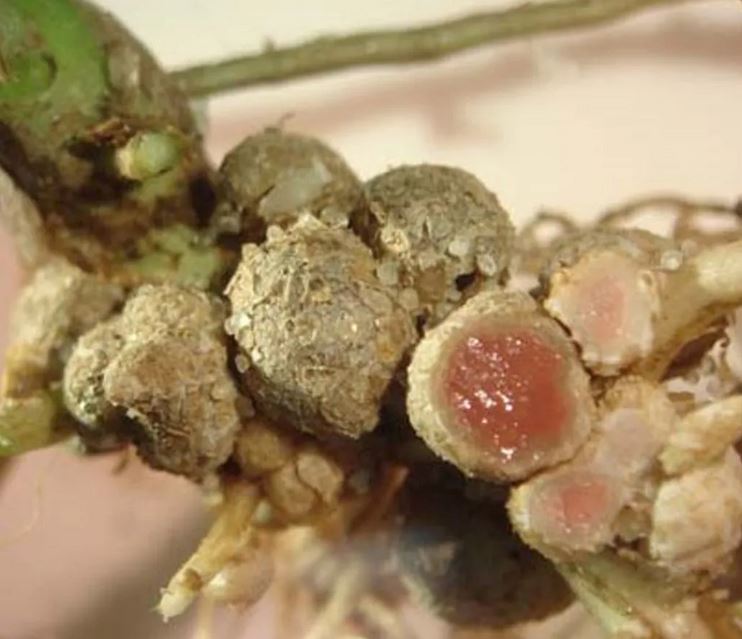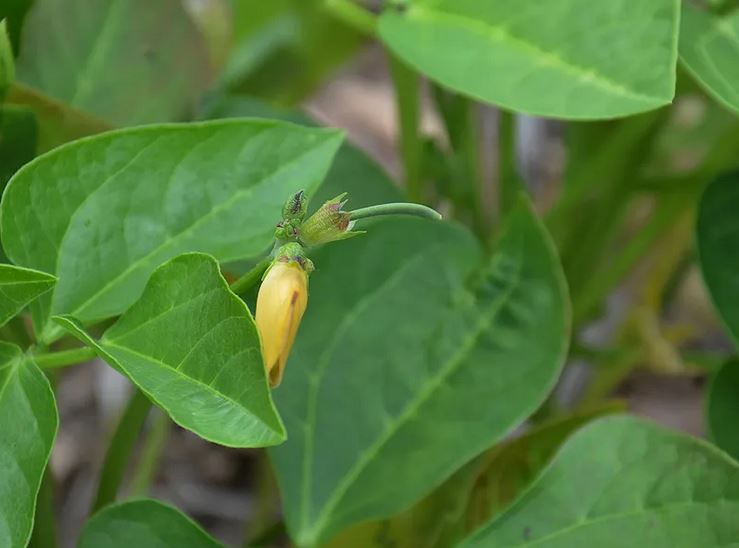USA
June 22, 2023
Do you grow peas, beans or other legumes in your backyard or garden? Have you ever heard about seed inoculation and how you can use it to produce more yield? The June 22nd Sustainable, Secure Food Blog, written by Lovepreet Singh, looks at using inoculated seed helps you get the most out of your plants.

Peas are a common garden crop that can be purchased pre-inoculated. The inoculant contains helpful bacteria that works with the pea plants’ roots to help them be higher yielding. Credit: SV Fisk
Seed inoculation can be understood as adding or mixing the useful bacteria to garden seeds. (Farmers also use inoculated seeds on farms!) The purpose of mixing is that correct type of bacteria can establish a successful symbiosis with the plant to fix atmospheric nitrogen for the plant so that you do not have to apply more fertilizer. Inoculation can also create better growth and yield of the crop.
Seed treatment is a bit different than seed inoculation. Seed treatment is when you expose seed to heat, cold, and soak it in water. Chemicals are then applied that will protect the growing plant from pests or for better seed germination.
Inoculation is important specially if the legume you are planting in soil where it was not planted in previous years. Then the inoculant will help in increasing the population of bacteria which will act in symbiosis with the plant to fix nitrogen for the plant.
How are inoculated seeds prepared?
Using peas as an example, seed companies would isolate the bacteria from root nodules of already healthy growing peas. They grow that bacterium in a laboratory. Usually this is done on a mass production scale for efficiency. The bacteria are then mixed with peat to increase the volume – and the inoculant is ready.
How should you inoculate?
You can purchase pre-inoculated seeds in which bacteria and seeds are already mixed. There are many companies which sell these seeds. You can also buy an inoculant mixture alone – and mix it with your seeds or in your soil. A good tip is to add some sugar or sticking agent to help the inoculant mixture stick to the seed or soil if you are mixing it by yourselves. Usually, farmers adopt the inoculant mixture process when they must plant on a bigger scale. The soil inoculation can be good method if you have already planted your seeds.
Seed inoculants are safe and have been found to no negative effects on seeds – even if you over-inoculate. It means they are perfect for home gardeners as well as they do not need additional practice to follow.
The inoculants should be handled with extra care as they have fragile and sensitive microorganisms. Exposing inoculants to heat, direct sunlight, excessive moisture, or extreme conditions can kill microbes present and leaving it to no use. (Just like many probiotics should be stored in the refrigerator).

Rhizobia nodules: The bright red color of the opened nodule is an indication of healthy rhizobia (bacteria) inside. Like hemoglobin in humans, plants have leghemoglobin which binds with atmospheric oxygen and helps the nitrogen fixation process. Like hemoglobin, leghemoglobin turns red when in contact with oxygen testifying to its active status. Credit: Jennifer Dean via Creative Commons 2.0 License
About the bacteria and what is really happening?
The bacteria which establish a symbiotic relationship with the legumes and help in fixing atmospheric nitrogen belongs to genus Rhizobia. The different species of this bacteria are specific according to the legume or plant. Rhizobia infects the root hairs of legumes and form little swellings on roots of plants called as root nodules.
These nodules convert the atmospheric nitrogen into soluble nitrogen compounds through complex biochemical processes. Once they do that, this soluble nitrogen can be used by the plants. In return for helping the plant with its nitrogen requirement, the plant helps the bacteria! (Thus, it’s called symbiotic). The plants make carbohydrates that the bacterium then “eat.”
If you uproot a plant and see greater number of nodules on roots, you can tell this plant has greater potential for nitrogen fixation. If you’re interested in seeing if the process is working, trying this test: cut down the middle of a nodule. If it shows a red color means it is actively working. Like hemoglobin in humans, plants have leghemoglobin which binds with atmospheric oxygen and helps the nitrogen fixation process. Like hemoglobin, leghemoglobin turns red when in contact with oxygen testifying to its active status.

Black-eyed peas (cowpeas) are another popular garden crop that is in the legume family. They can be bought pre-inoculated, or a gardener can mix inoculant with seed or to the soil. Legumes are plants that are able to work with soil bacteria (inoculants are bacteria) to fix nitrogen from the air, providing nutrition to the plant. In return, the bacteria enjoy a healthy meal of carbohydrates produced by the plant, which is called symbiosis. Credit: SV Fisk
What about non-legumes and other microbes?
There are some fungi and bacteria which provide nutrients to plants both by acting in symbiotic relationship or as free-living nitrogen fixers. There is one special mycorrhizal fungi which also form symbiotic relationship with the plants and increase the uptake of phosphorus and water. It also has been found that mycorrhizal fungi increase the tolerance of some plants to different environmental stresses.
There are some microbes which do not form symbiotic relationship with the plants but are still beneficial to plants. If they promote plant growth, they are called biofertilizers. When they suppress plant diseases or pests they can be called as plant resistance stimulants or biopesticides.
Biofertilizers are again the living microorganisms which lives around the root area of plants and secrete some organic acids. These chemicals either dissolve the minerals and make nutrients available to plants or these chemicals act as growth hormones to promote root/plant growth. The biopesticide or biocontrol agents are which suppress plant diseases and makes plant healthy. Excellent example is Trichoderma which kills the bad fungus by secreting harmful chemicals or stealing nutrients from them.
To read more about the research findings and the entire blog, visit: https://sustainable-secure-food-blog.com/2023/06/22/why-should-i-buy-inoculated-seeds-for-my-garden/
This blog is part of Crop Science Society of America’s Seed Week celebration. Why celebrate seeds? Anyone who plants a seed is investing in hope. That’s one of the attractions of seeds. For the gardener, it could be hope for a beautiful flower, or perhaps a delicious zucchini squash. For our farmers, seeds are the hope of this year’s yields of produce, cash crops or forage. No matter the size or shape of the seed, they all can bring forth new life. At Crop Science Society of America, we hold seeds in very high regard. Please visit our Seed Week webpage for news stories, blogs and more information about seed research and facts.